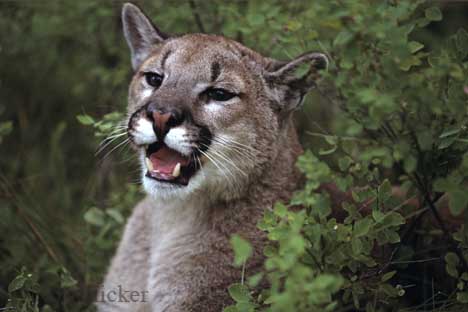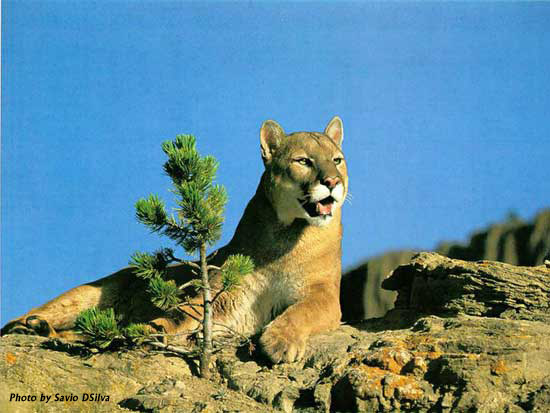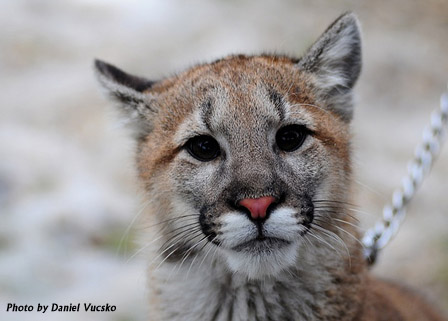"So, what's so special about this big cat?"
Interesting Facts
 |
The average weight of a male cougar is anywhere from 145 to 165 pounds while the average weight of a female cougar ranges from 75 to 100 pounds. However, the largest cougar ever identified was a male cougar that weighed nearly 200 pounds! The average length (measured with its tail) of a male cougar is about 11 feet long whereas the average length of a female cougar is around 8 feet long. Cougars have five toes on their forefeet and four toes on their hind feet which is similar to other felid species. |
Below is a comparison of a cougar
track and a dog track. The front toes of cougar tracks are not straight
like dog tracks. The heel of a puma track has three even lobes whereas the heel
of a dog track is most often only two-lobed or it
may have a very small center lobe. Dog tracks normally show toenail marks
while cougar tracks usually do not.
Interactions with other species
 Because cougars are such solitary animals, they rarely intentionally interact
with other species.
But the feeling
is mutual because other species rarely want to live amongst the cougar due to
its predacious behavior. Cougars do not eat the entire body of their prey and
leave parts behind- this proves beneficial to fungi, bacteria, and other
saprophytes because it leaves these particular organisms a "free" food source.
Wolves prove to
be a hefty threat to cougars because they compete for the same food sources and
have better olfactory senses for hunting. The biggest threat to cougars is
humans.
Humans hunt cougars for
game, they hunt them to prevent stock depredation, and they hunt them out of fear.
Humans also hunt
deer which are the main source of food for
cougars.
Fewer
deer means less food for the cougars. Trophy hunting is
also one of the main causes of mortality among the
Puma species, and this is
especially the case when the mother cougar is killed and her cub is orphaned.
Because cougars are such solitary animals, they rarely intentionally interact
with other species.
But the feeling
is mutual because other species rarely want to live amongst the cougar due to
its predacious behavior. Cougars do not eat the entire body of their prey and
leave parts behind- this proves beneficial to fungi, bacteria, and other
saprophytes because it leaves these particular organisms a "free" food source.
Wolves prove to
be a hefty threat to cougars because they compete for the same food sources and
have better olfactory senses for hunting. The biggest threat to cougars is
humans.
Humans hunt cougars for
game, they hunt them to prevent stock depredation, and they hunt them out of fear.
Humans also hunt
deer which are the main source of food for
cougars.
Fewer
deer means less food for the cougars. Trophy hunting is
also one of the main causes of mortality among the
Puma species, and this is
especially the case when the mother cougar is killed and her cub is orphaned.
SAVE THE COUGAR!
 In general, cougars are afraid of humans and will do anything in their power to
avoid them. Cougar attacks mostly occur because of inexperience.
Young cougars are not as particular about their definition of “prey” and
they become confused because their prey does not normally stand upright as in
the case with humans.
Cougar
attacks have increased within the last 20 years most likely due to humans moving
further into cougar country.
Nearly
everyone that has been attacked by a cougar and has turned to fight back has
survived.
It is hard to say if
humans and cougars will be able to co-exist in the future but hopefully that is
in fact the case.
In general, cougars are afraid of humans and will do anything in their power to
avoid them. Cougar attacks mostly occur because of inexperience.
Young cougars are not as particular about their definition of “prey” and
they become confused because their prey does not normally stand upright as in
the case with humans.
Cougar
attacks have increased within the last 20 years most likely due to humans moving
further into cougar country.
Nearly
everyone that has been attacked by a cougar and has turned to fight back has
survived.
It is hard to say if
humans and cougars will be able to co-exist in the future but hopefully that is
in fact the case.
|
|
Humans have killed somewhere between 100,000 to 250,000 cougars since Click on the links below to learn how you can help save the cougar. http://www.cougarfund.org/ http://www.cougarnet.org/index.html |
Home
Classification
Habitat
Reproduction
Nutrition
Adaptations
Interesting facts
About me
References
Multipleorganisms.net